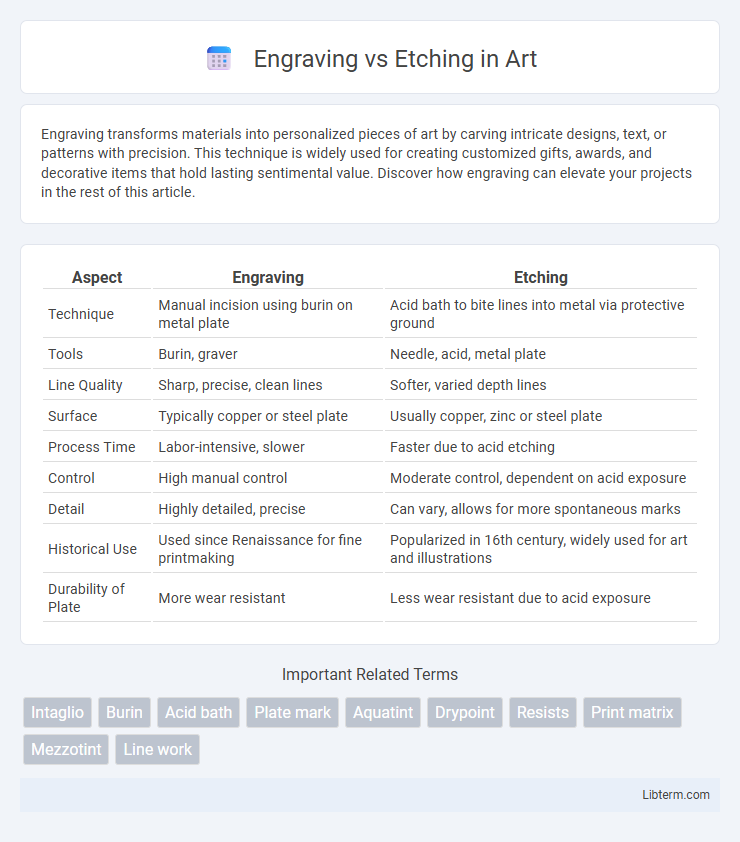Engraving transforms materials into personalized pieces of art by carving intricate designs, text, or patterns with precision. This technique is widely used for creating customized gifts, awards, and decorative items that hold lasting sentimental value. Discover how engraving can elevate your projects in the rest of this article.
Table of Comparison
| Aspect | Engraving | Etching |
|---|---|---|
| Technique | Manual incision using burin on metal plate | Acid bath to bite lines into metal via protective ground |
| Tools | Burin, graver | Needle, acid, metal plate |
| Line Quality | Sharp, precise, clean lines | Softer, varied depth lines |
| Surface | Typically copper or steel plate | Usually copper, zinc or steel plate |
| Process Time | Labor-intensive, slower | Faster due to acid etching |
| Control | High manual control | Moderate control, dependent on acid exposure |
| Detail | Highly detailed, precise | Can vary, allows for more spontaneous marks |
| Historical Use | Used since Renaissance for fine printmaking | Popularized in 16th century, widely used for art and illustrations |
| Durability of Plate | More wear resistant | Less wear resistant due to acid exposure |
Understanding Engraving and Etching: Key Differences
Engraving involves physically carving or cutting into a surface using tools or machines to create precise, permanent designs, while etching employs acid or chemical solutions to corrode the surface and form patterns. The primary difference lies in technique: engraving is a mechanical process providing sharp, detailed lines, whereas etching relies on chemical reactions for softer, more varied textures. Materials such as metal, glass, and wood respond differently to these methods, making the choice between engraving and etching dependent on desired depth, detail, and visual effect.
The Historical Evolution of Engraving and Etching
Engraving, traced back to the Renaissance period, involved incising designs onto hard surfaces using a burin, becoming pivotal in printmaking and fine art. Etching emerged in the 16th century as a chemical process where acid bites into a metal plate, offering artists greater flexibility and detail compared to engraving. Both techniques evolved significantly during the Industrial Revolution, incorporating mechanization that expanded their applications in printing, currency, and decorative arts.
Core Techniques: How Engraving Works
Engraving involves manually cutting designs into a hard surface using a sharp tool called a burin, creating precise grooves that hold ink for printing or decorative purposes. This technique allows for high detail and depth control, making it ideal for metal, wood, and glass art. The process requires skill and steady pressure to carve intricate patterns directly onto the material.
Core Techniques: How Etching Works
Etching involves coating a metal plate with a resist, then scratching the design into the resist to expose the metal beneath. The plate is submerged in an acid bath, where the acid bites into the exposed areas, creating grooves that hold ink for printing. This chemical process allows for finer lines and greater detail compared to the physical incision used in engraving.
Materials and Tools Used in Each Method
Engraving uses sharp tools like burins and gravers to carve directly into hard materials such as metal, wood, or glass, producing precise, controlled lines. Etching involves coating a metal plate with an acid-resistant ground before using tools to expose areas that are then bitten by acid, making it ideal for softer metals like copper and zinc. The materials and tools choice directly influences the detail and texture achievable in each printmaking technique.
Visual Results: Comparing Engraving and Etching
Engraving produces sharp, precise lines with deep grooves that reflect light distinctly, resulting in high-contrast visuals and fine detail ideal for intricate designs. Etching creates softer, more varied line qualities with subtle tonal gradients due to acid's ability to bite into the metal unevenly, offering a more textured and nuanced appearance. Visual results in engraving emphasize clarity and depth, whereas etching delivers fluidity and artistic expressiveness.
Durability and Longevity of Engraved vs Etched Designs
Engraved designs exhibit superior durability and longevity due to the direct cutting of material, creating deep, permanent markings resistant to wear and environmental factors. In contrast, etched designs rely on chemical processes that produce shallower impressions, making them more susceptible to fading and surface damage over time. This fundamental difference ensures engraved artwork maintains clarity and detail far longer than etched counterparts in high-use or outdoor applications.
Applications: Common Uses of Engraving and Etching
Engraving is commonly used for creating detailed designs on metal surfaces, such as jewelry, trophies, and industrial parts, due to its precision and durability. Etching is frequently applied in the production of circuit boards, artistic prints, and glass decoration, where intricate patterns are needed with less mechanical pressure. Both techniques serve critical roles in manufacturing, security marking, and art, each optimized for specific material interactions and design complexities.
Cost and Accessibility: Which Method is More Practical?
Engraving typically involves higher costs due to the need for specialized tools and skilled labor, making it less accessible for small-scale or DIY projects. Etching offers a more cost-effective alternative, utilizing simpler equipment and materials, which enhances accessibility for hobbyists and small businesses. For practical, budget-conscious applications, etching is generally the preferred method due to its lower entry barriers and reduced production expenses.
Choosing Between Engraving and Etching: Factors to Consider
Choosing between engraving and etching depends on factors such as desired detail, material type, and production volume. Engraving offers precise, deep cuts ideal for metal and durable designs, while etching suits intricate patterns on softer materials through chemical processes. Consider cost, durability, and artistic effect to determine the best method for your project.
Engraving Infographic

 libterm.com
libterm.com